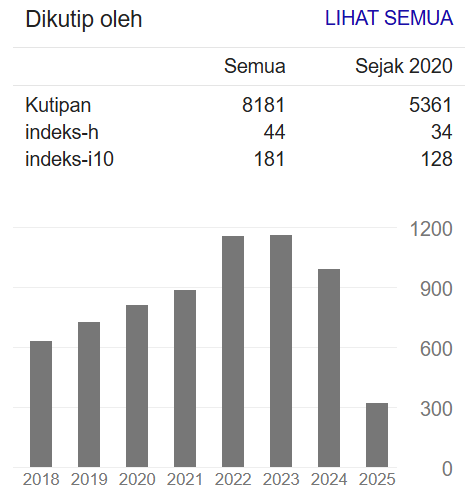HUBUNGAN KRONOTIPE DENGAN DERAJAT NYERI DISMENORE PADA REMAJA PUTRI
DOI:
https://doi.org/10.34011/jmp2k.v33i4.1786Keywords:
Dysmenorrhea Pain, Chronotype, AdolescentAbstract
Dysmenorrhea is one of the most common menstrual disorders in young women. The prevalence of dysmenorrhea in adolescent girls in Indonesia ranges from 16.8-81%. Girls with dysmenorrhea symptoms have a higher risk of decreased activity, experiencing hip strain, back pain, headaches, and fatigue. In school children, it can interfere with learning activities and concentration, causing academic decline. Dysmenorrhea is influenced by several factors from daily activities and habits. Activity can affect a person's sleep and wake schedule. The difference in sleep and activity schedules of each person is known as kronotipe. The study aimed to determine the relationship between kronotipe and the degree of dysmenorrhea pain in adolescent girls at SMKN 1 Doko Blitar. The research was conducted in August-September 2021. The population of the study was 60 students of SMK 1 Doko in Blitar district aged 15-18 years old, non-smoking, and who want to join this study. The research plan is a cross-sectional study using MEQ-SA (Morningness-Eveningness Questionnaire Self-Assessment Version), and the dysmenorrhea questionnaire. Data analysis uses the chi-square test. The result of chi-square test showed a significant correlation between the kronotipe with the degree of dysmenorrhea pain (p-value= 0,000). There is a significant relationship between chronotype and the degree of dysmenorrhea pain. Adolescent girls need to set a regular sleep schedule to have an appropriate chronotype to reduce dysmenorrhea pain during menstruation.
References
Kementerian Kesehatan RI, “Infodatin Reproduksi Remaja-Ed.Pdf,” Jakarta : Info Pusat Data Kementerian Kesehatan RI, 2014.
I. D. Kusumaningrum, “Mengenal Gangguan Menstruasi Pada Remaja Putri,” J. Community Empower., vol. 2, no. 3, pp. 133–138, 2020.
I. W. S. Putri and N. W. Gati, “Gambaran Skala Nyeri Haid (Dismenorea) Pada Remaja Putri Di Desa Tanjungrejo Kabupaten Sukoharjo,” Nurs. News J. Ilm. Keperawatan, vol. 7, no. 1, pp. 1–10, 2023, doi: 10.33366/nn.v7i1.2541.
U. R. Ammar, “Faktor Risiko Dismenore Primer pada Wanita Usia Subur di Kelurahan Ploso Kecamatan Tambaksari Surabaya,” J. Berk. Epidemiol., vol. 4, no. 1, pp. 37–49, 2016, doi: 10.20473/jbe.v4i1.37-49.
A. Wulandari, Rodiyani, and R. D. P. Sari, “Pengaruh Pemberian Ekstrak Kunyit ( Curcuma longa linn ) dalam Mengatasi Dismenorea [Effect of Turmeric Extract (Curcuma longa linn) in Reducing Dysmenorrhoea],” Majority, vol. 7, no. 2, pp. 193–197, 2018.
R. A. Farahdilla, D. Danial, I. Muda, M. K. Nuryanto, and S. Hastati, “Hubungan Tingkat Kecemasan Dan Kualitas Tidur Dengan Kejadian Dismenorea Primer Pada Mahasiswi Kedokteran,” J. Kedokt. Mulawarman, vol. 8, no. 2, p. 44, 2021, doi: 10.30872/j.ked.mulawarman.v8i2.6368.
M. Armour et al., “The Prevalence and Academic Impact of Dysmenorrhea in 21,573 Young Women: A Systematic Review and Meta-Analysis,” Journal of Women’s Health. vol. 28, no. 8, pp 1161-1171 , 2019. doi:10.1089/jwh.2018. 7615.
S. Hailemeskel, A. Demissie, and N. Assefa, “Primary dysmenorrhea magnitude, associated risk factors, and its effect on academic performance: Evidence from female university students in Ethiopia,” Int. J. Womens. Health, vol. 8, pp. 489–496, 2016, doi: 10.2147/IJWH.S112768.
R. Manorek et al., “Hubungan Antara Status Gizi Dengan Kejadian Dismenore Pada Siswi Kelas XI Sma Negeri 1 Kawangkoan" Universitas Sam Ratulangi, 2014
F. H. Mazri, Z. A. Manaf, S. Shahar, and A. F. M. Ludin, The association between chronotype and dietary pattern among adults: A scoping review, vol. 17, no. 1. 2020. doi: 10.3390/ijerph17010068.
G. L. N. Rique, G. M. C. F. Filho, A. D. C. Ferreira, and R. L. De Sousa-Muñoz, “Relationship between chronotype and quality of sleep in medical students at the federal university of Paraiba, Brazil,” Sleep Sci., vol. 7, no. 2, pp. 96–102, 2014, doi: 10.1016/j.slsci.2014.09.004.
C. Vetter, D. Fischer, J. L. Matera, and T. Roenneberg, “Aligning work and circadian time in shift workers improves sleep and reduces circadian disruption,” Curr. Biol., vol. 25, no. 7, pp. 907–911, 2015, doi: 10.1016/j.cub.2015.01.064.
R.Ristl.(Januari,2021).Sample size calculation for non-parametric [Online]. Available: https://homepage.univie.ac.at/robin.ristl/samplesize.php
N. Treven Pišljar, V. Štukovnik, G. Zager Kocjan, and L. Dolenc-Groselj, “Validity and reliability of the Slovene version of the Morningness-Eveningness Questionnaire,” Chronobiol. Int., vol. 36, no.10, pp 1409-1417, 2019, doi: 10.1080/07420528.2019.1651326.
F. Afghaniy, “Hubungan antara Chronotype dengan Prestasi Belajar pada Siswa Kelas XI di SMAN 1 Boyolali,” Skripsi, Fakultas Kedokteran, Universitas Muhammadiyah Surakarta, 2017.
I. P. Artawan, Ik. A. A. IKetut Alit Adianta, and I. A. M. D. Ida Ayu Manik Damayanti, “Hubungan Nyeri Haid (Dismenore Primer) Dengan Kualitas Tidur Pada Mahasiswi Sarjana Keperawatan Tingkat Iv Itekes Bali Tahun 2022,” J. Ris. Kesehat. Nas., vol. 6, no. 2, pp. 94–99, 2022, doi: 10.37294/jrkn.v6i2.412.
L. D. Akacem, K. G. Garlo, and M. K. Lebourgeois, “and Sleep in Toddlers,” vol. 23, no. 4, pp. 397–405, 2015, doi: 10.1111/jsr.12142.Chronotype.
D. Ono, K. I. Honma, and S. Honma, “Circadian And Ultradian Rhythms Of Clock Gene Expression In The Suprachiasmatic Nucleus Of Freely Moving Mice,” Sci. Rep., vol. 5, no. 1, pp. 12310 2015, doi: 10.1038/srep12310.
M. Haack, E. Sanchez, and J. M. Mullington, “Elevated inflammatory markers in response to prolonged sleep restriction are associated with increased pain experience in healthy volunteers,” Sleep,vol 30, no 9 , pp 1145-1152, 2007, doi: 10.1093/sleep/30.9.1145.
L. Duo, X. Yu, R. Hu, X. Duan, J. Zhou, and K. Wang, “Sleep disorders in chronic pain and its neurochemical mechanisms: a narrative review,” Frontiers in Psychiatry. vol. 14: 1157790, no 2023. doi: 10.3389/fpsyt.2023.1157790.




